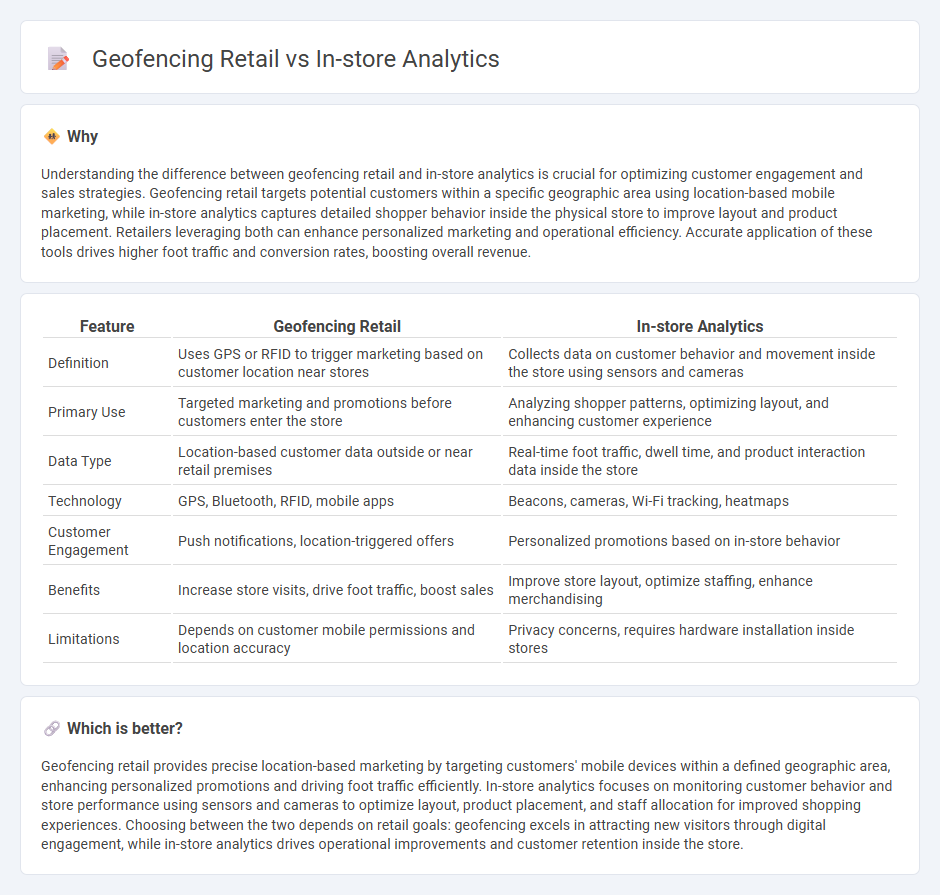
Geofencing retail leverages location-based technology to create virtual boundaries, sending targeted promotions to customers' mobile devices as they enter defined zones, driving foot traffic and enhancing customer engagement. In-store analytics focus on gathering real-time data on shopper behavior within physical stores, optimizing layout, staff allocation, and inventory management to boost sales and customer experience. Explore how combining geofencing and in-store analytics transforms retail strategies for measurable growth.
Why it is important
Understanding the difference between geofencing retail and in-store analytics is crucial for optimizing customer engagement and sales strategies. Geofencing retail targets potential customers within a specific geographic area using location-based mobile marketing, while in-store analytics captures detailed shopper behavior inside the physical store to improve layout and product placement. Retailers leveraging both can enhance personalized marketing and operational efficiency. Accurate application of these tools drives higher foot traffic and conversion rates, boosting overall revenue.
Comparison Table
| Feature | Geofencing Retail | In-store Analytics |
|---|---|---|
| Definition | Uses GPS or RFID to trigger marketing based on customer location near stores | Collects data on customer behavior and movement inside the store using sensors and cameras |
| Primary Use | Targeted marketing and promotions before customers enter the store | Analyzing shopper patterns, optimizing layout, and enhancing customer experience |
| Data Type | Location-based customer data outside or near retail premises | Real-time foot traffic, dwell time, and product interaction data inside the store |
| Technology | GPS, Bluetooth, RFID, mobile apps | Beacons, cameras, Wi-Fi tracking, heatmaps |
| Customer Engagement | Push notifications, location-triggered offers | Personalized promotions based on in-store behavior |
| Benefits | Increase store visits, drive foot traffic, boost sales | Improve store layout, optimize staffing, enhance merchandising |
| Limitations | Depends on customer mobile permissions and location accuracy | Privacy concerns, requires hardware installation inside stores |
Which is better?
Geofencing retail provides precise location-based marketing by targeting customers' mobile devices within a defined geographic area, enhancing personalized promotions and driving foot traffic efficiently. In-store analytics focuses on monitoring customer behavior and store performance using sensors and cameras to optimize layout, product placement, and staff allocation for improved shopping experiences. Choosing between the two depends on retail goals: geofencing excels in attracting new visitors through digital engagement, while in-store analytics drives operational improvements and customer retention inside the store.
Connection
Geofencing retail leverages location-based technology to create virtual boundaries around stores, triggering targeted marketing and personalized notifications when customers enter these zones. In-store analytics collect real-time data on customer behavior, traffic patterns, and dwell times within these geofenced areas to optimize store layouts and product placements. Together, geofencing and in-store analytics enhance customer engagement and drive sales through precise, data-driven retail strategies.
Key Terms
Foot Traffic Analysis
In-store analytics leverages sensors and cameras to monitor foot traffic patterns within retail spaces, providing granular data on customer movement and dwell times. Geofencing retail uses GPS and Bluetooth technology to create virtual boundaries outside the store, capturing foot traffic data and triggering targeted marketing based on customer proximity. Explore the advantages and insights of both technologies to optimize retail foot traffic analysis effectively.
Location-based Marketing
In-store analytics leverages data from sensors and cameras to track customer behavior and movement patterns within retail spaces, optimizing store layouts and personalized marketing efforts. Geofencing employs GPS or RFID technology to create virtual boundaries, triggering targeted promotions and notifications when consumers enter or exit these zones, enhancing location-based marketing precision. Explore the detailed advantages and applications of both technologies to maximize your retail marketing strategy.
Heatmaps
In-store analytics leverages heatmaps to track customer movements and dwell times, optimizing store layouts for enhanced shopping experiences. Geofencing retail uses location-based technology to create virtual boundaries, sending targeted promotions as customers enter or leave specific zones. Explore how these technologies transform retail strategies by delving deeper into their comparative benefits and applications.
Source and External Links
In-store Analytics Market Size, Share & Growth Report, 2030 - In-store analytics involves technologies like sensors and IoT devices to track customer behavior and store traffic in real time, enabling retailers to optimize layouts, inventory, and marketing for a personalized shopping experience and operational efficiency, driving a market projected to grow at a 21.8% CAGR through 2030.
In-store Analytics in Retail - Shoppermotion - In-store analytics provides retailers with real-time insights into customer behavior to improve inventory management, personalize shopping experiences through targeted recommendations and offers, detect trends, and ultimately increase customer satisfaction, loyalty, and sales.
Refine Consumer Experience with Retail In-Store Analytics - Retail in-store analytics analyzes customer journeys, store traffic, and sales data to help retailers optimize operations including queue management, marketing, sales, and supply chain strategies, enhancing both consumer experience and revenue.
 dowidth.com
dowidth.com